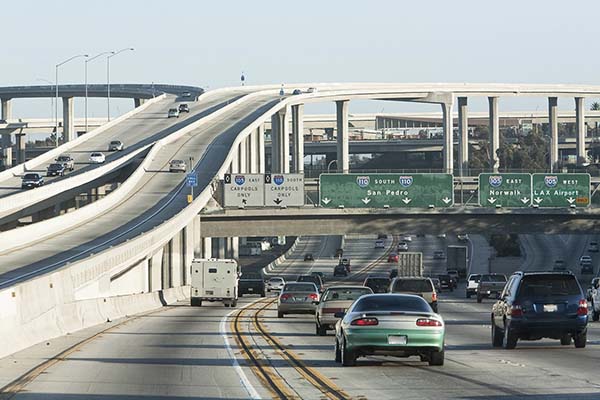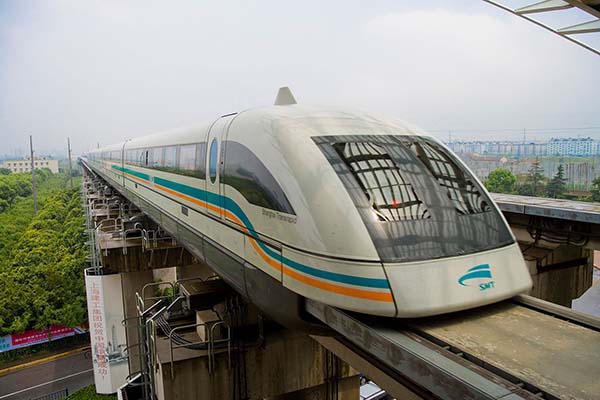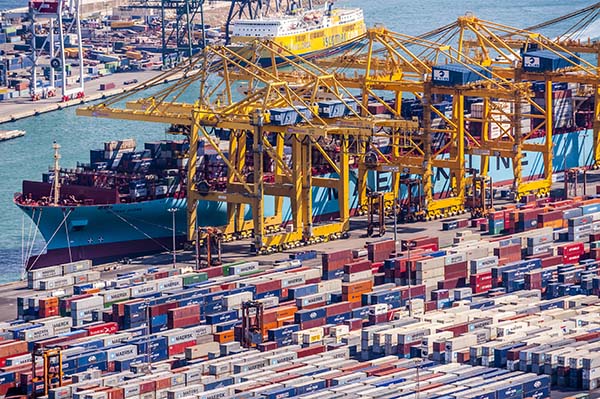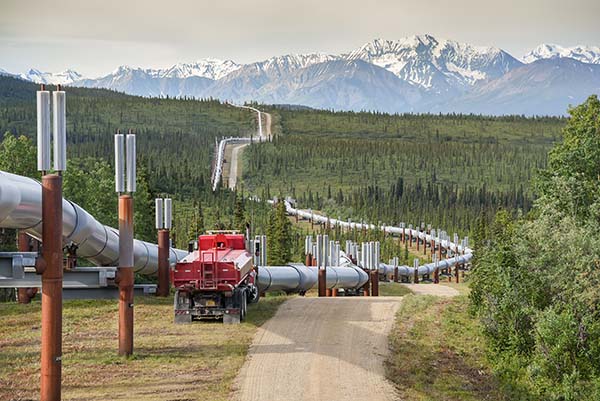Key Concepts
That branch of engineering related to the movements of goods and people by highway, rail, air, water, and pipeline. Special categories include urban and intermodal transportation.
Highway transportation
Engineering for highway transportation involves planning, construction, and operation of highway systems (Fig. 1), urban streets, roads, and bridges, as well as parking facilities. Important aspects of highway engineering include (1) overall planning of routes, financing, environmental impact evaluation, and value engineering to compare alternatives; (2) traffic engineering, which plans for the volumes of traffic to be handled, the methods to accommodate these flows, the lighting and signing of highways, and general layout; (3) pavement and roadway engineering, which involves setting of alignments, planning the cuts and fills to construct the roadway, designing the base course and pavement, and selecting the drainage system; and (4) bridge engineering, which involves the design of highway bridges, retaining walls, tunnels, and other structures. See also: Highway bridge; Highway engineering; Retaining wall; Traffic-control systems; Tunnel

Highway transportation engineers face the challenge of moving increasing volumes of traffic over existing routes while improving safety records. Therefore, a major initiative was launched in the United States to develop technology for a nationwide intelligent transportation system. In urban areas, such systems are being designed to feature increased use of vehicle detection systems, video cameras, variable message signs, and electronic toll collection with automatic vehicle identification. Posted speed limits change automatically according to traffic flow. In more remote areas, sensors on highways are being designed to detect unsafe conditions such as slippery roads, relay the information via radio waves to a central computer, and transmit a warning via satellite to individual vehicles. Cars also are being equipped with crash-warning and avoidance systems. See also: Active traffic management; Connected vehicles; Intelligent transportation systems
Rail transportation
Engineering for railway transportation involves planning, construction, and operation of terminals, switchyards, loading/unloading facilities, trackage, bridges, tunnels, and traffic-control systems for freight and passenger service. For freight operations, there is an emphasis on developing more efficient systems for loading, unloading, shifting cars, and operating trains. Facilities include large marshaling yards where electronic equipment is used to control the movement of railroad cars. Also, there is a trend to developing more automated systems on trackage whereby signals and switches are set automatically by electronic devices. To accommodate transportation of containers, tunnels on older lines are being enlarged to provide for double-stack container cars. See also: Railroad control systems; Railway engineering
Rail passenger service has long been an important part of the overall transportation system, including high-speed systems. Magnetic levitation (maglev) systems are mostly under development, in which cars on a frictionless magnetic suspension are propelled along guideways by linear induction motors. A few short (30 km or less) systems are operating in China (Fig. 2) and Japan. See also: High-speed rail; Magnetic levitation

Air transportation
Engineering for air transportation encompasses the planning, design, and construction of terminals, runways, and navigation aids to provide for passenger and freight service. High-capacity, long-range, fuel-efficient aircraft are desirable. Wider use of composites and the substitution of electronic controls for mechanical devices reduce weight to improve fuel economy. Smaller planes are more efficient for shorter runs. See also: Air transportation; Composite materials
Runways must be of sufficient size to safely accommodate landings and takeoffs. Navigation aids and other instrumentation, such as for the detection of destructive wind shears or approaching aircraft, are being developed and deployed to enhance safety. See also: Air navigation; Air-traffic control
As air transportation continues to grow, increased emphasis is placed on terminal designs that facilitate the rapid movement of passengers and baggage. Extensive conveyor belt systems with electronic identifications have been installed in the newer facilities to speed movement of baggage from planes to common central areas. At the larger airports, moving sidewalks are commonly used to move passengers through widely dispersed gate areas. Also, computer-controlled shuttle cars without operators (people movers) are used to move people rapidly from central areas to gate areas. In some cases, rapid transit rail facilities or dedicated busways are available to carry passengers directly from the airport to central business districts. As airways continue to concentrate flights in large hub operations to increase efficiency, engineers and planners focus on developing improved facilities to speed the transfer of passengers and baggage. See also: Airport engineering
Air freight cargo facilities are increasingly being automated and feature computer-controlled systems, including automated distribution conveyors, transfer vehicles, and stacking cranes. Robotic cranes load and unload boxes and lightweight containers.
Water transportation
Engineering for water transportation entails the design and construction of a vast array of facilities such as canals, locks and dams, and port facilities. The transportation system ranges from shipping by barge and tugboat on inland waterways to shipping by oceangoing vessels. Although there is some transportation of passengers, such as on ferries and cruise ships, water transportation is largely devoted to freight. See also: Barge technology; Canal; Dam
Special facilities are required for loading and unloading oceangoing vessels (Fig. 3). For example, supertankers require special offshore mooring where the oil can be rapidly pumped to shore through pipelines. Also, unit trains of 100 or more railcars, carrying bulk products such as grain or coal, require rapid unloading facilities for efficient operations. See also: Harbors and ports

Pipeline transportation
Pipeline engineering embraces the design and construction of pipelines, pumping stations, and storage facilities. Pipelines are used to transport liquids such as water, gas, and petroleum products over great distances. Also, products such as pulverized coal and iron ore can be transported in a water slurry.
Water pipelines, probably the most common. Pipelines are often underground, but may run aboveground, particularly in lightly populated areas. Either submerged lines or bridges are required at stream crossings. One aboveground line is the Trans-Alaska pipeline (Fig. 4), which was constructed to transport oil from near Prudhoe Bay on the Arctic Ocean to the city of Valdez on the Gulf of Alaska.

Consideration must be given to route selection, determining the appropriate diameter and thickness of pipe, installation (trench construction, backfilling, and compaction), and durability. Installation under highways, rivers, and other difficult areas is sometimes done using microtunneling techniques to avoid disturbing the surface. Design of pumping facilities requires study of power requirements for different types of material moved, standby facilities, and related considerations. See also: Pipeline
Urban transportation
Engineering for urban transportation concerns the design and construction of light rail systems, subways, and people-movers, as well as facilities for traditional bus systems. To enhance public acceptance of new and expanded systems, increased use is being made of computer-aided design (CAD) to visualize alternatives for stations and facilities. Also, animated video systems are used for interactive visualization of plans. See also: Computer-aided engineering
As congestion in urban areas grows, increased emphasis is being placed on the construction and expansion of subways in major cities. Tunnel-boring machines and segmental liners are often used, along with various techniques to mobilize the strength of the surrounding soil or rock. Light-rail cars are used interchangeably aboveground on controlled right-of-ways or underground through tunnels. See also: Subway engineering
In some cities, high-occupancy vehicle lanes have been used to encourage car pooling. Typically these special lanes are reserved during rush hours for vehicles with three or more passengers.
Intermodal transportation
Intermodal transportation, often referred to as containerization, entails the use of special containers to ship goods by truck, rail, or ocean vessel. Engineers must design and construct intermodal facilities for efficient operations. The containers are fabricated from steel or aluminum, and they are designed to withstand the forces from handling. The ships are constructed with a cellular grid of compartments for containers below deck, and they can accommodate one or two layers on deck as well. Advantages include savings in labor costs, less pilferage, and lower insurance costs.
Seaports have special facilities for handling the containers, which arrive by rail or truck. Such facilities, which are found throughout the major port cities, are designed to speed the transfer of freight. At major inland centers, intermodal facilities combine loading and handling facilities for containers from truck trailers and rail flatcars. See also: Hoisting machines; Marine containers; Merchant ship
Environmental considerations
The environment is a major consideration in planning, designing, and constructing transportation facilities. Extensive legislation at both federal and state levels has set forth requirements with the objective of protecting the health and welfare of the general public.
Because of the vast material quantities used to construct and maintain transportation systems, opportunities abound for the use of reclaimed and recycled resources. For example, in the production of new pavement, 20% or more of the content can be from old asphalt pavement that has been removed in repaving operations. Old concrete pavements can also be recycled, as aggregate for new concrete or for base layers. Industrial wastes such as fly ash and blast-furnace slag can be used in concrete. Many uses have been found for scrap tires, such as for erosion control devices, for safety devices (tire-sand inertial barriers), in chipped form to create a lightweight bridge approach embankment or to reduce earth pressure against abutment walls, and in the manufacture of rubber asphalt. See also: Concrete; New generation of concretes; Pavement; Recycling technology
Energy considerations
Efforts to curb energy use arise from a variety of concerns, including national security issues and environmental implications. Limiting carbon dioxide emissions to stem global warming is a significant consideration. In addition to fuel economy standards, legislative approaches to date have focused on promoting cleaner and more efficient alternative fuels. As an example, natural gas is now used to fuel certain commercial vehicles in some areas. Efforts to relieve congestion in urban areas through incentives to make greater use of carpooling, such as special freeway lanes, and encouraging greater use of mass transit, deserve further emphasis. See also: Alternative fuels for vehicles; Global warming; Natural-gas-powered vehicles





